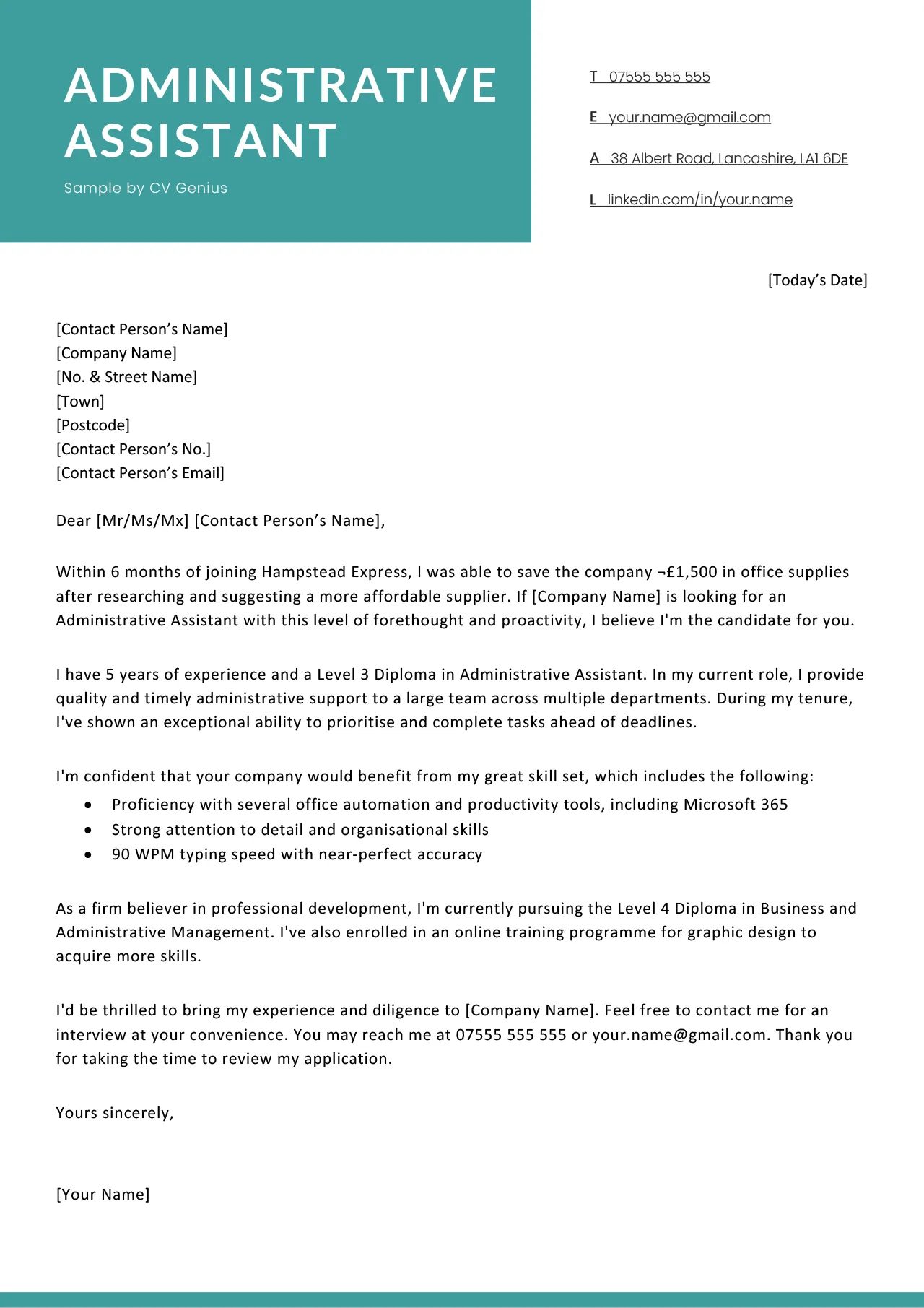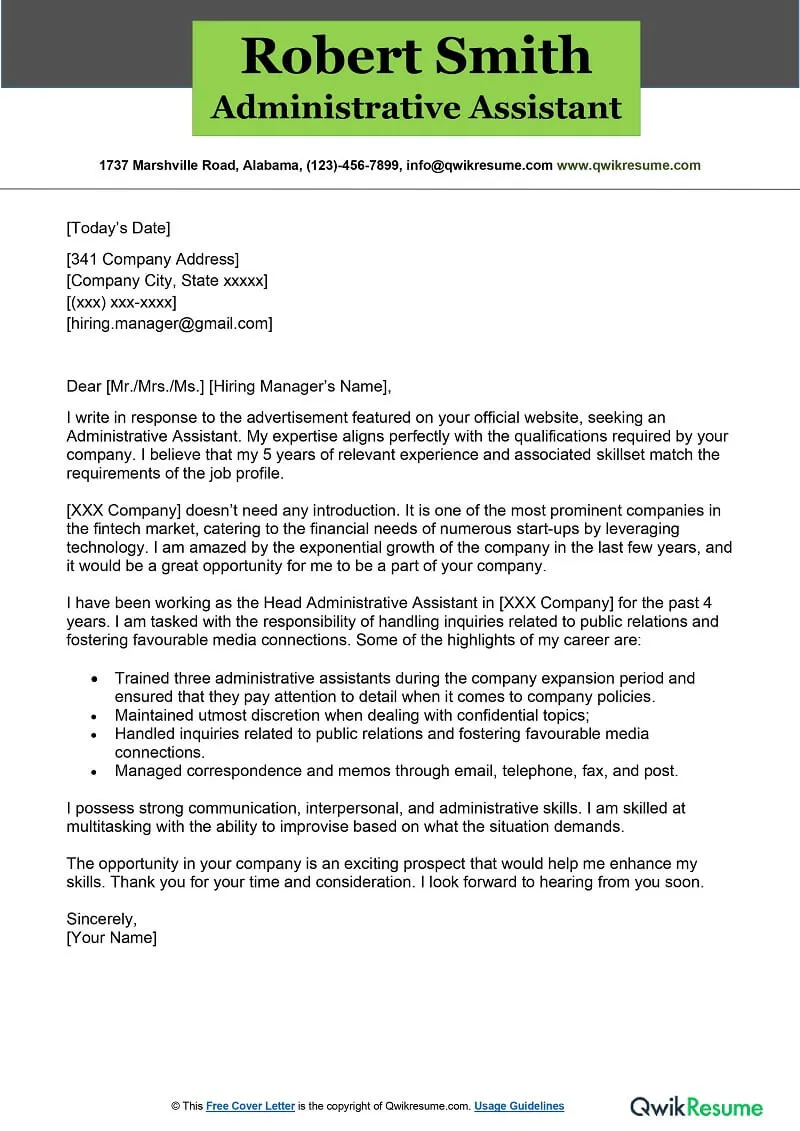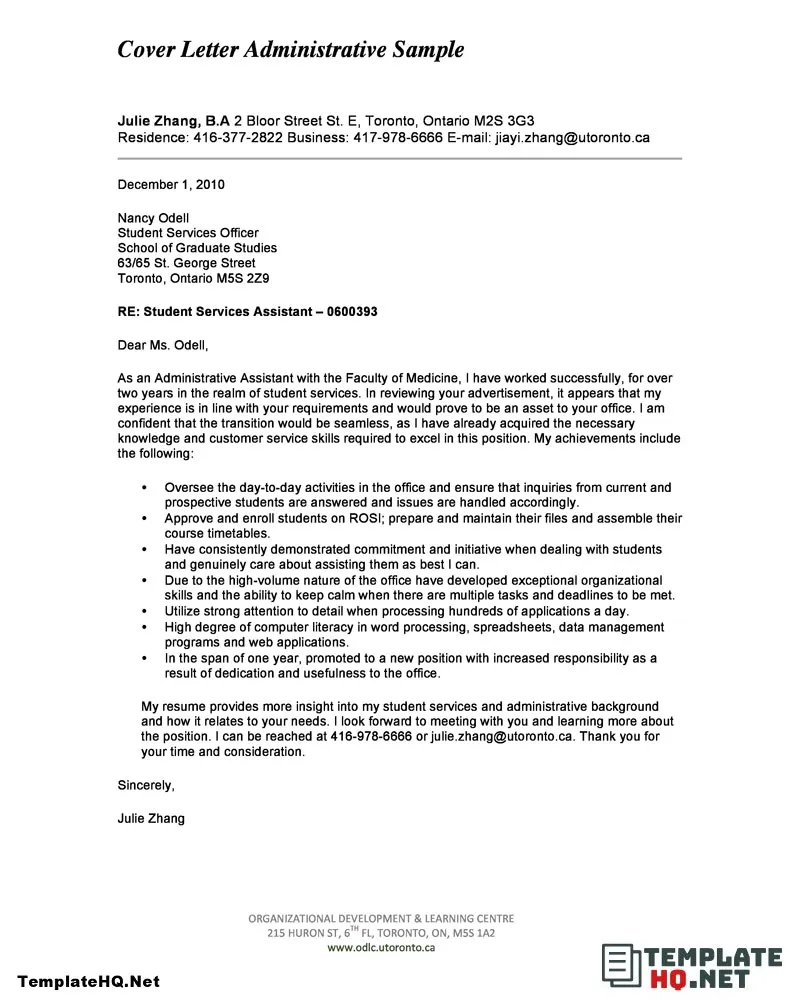Why a Strong Admin Cover Letter Matters
In the competitive landscape of job hunting, a compelling admin cover letter serves as your initial handshake with potential employers. It’s your first opportunity to make a lasting impression and distinguish yourself from the multitude of applicants vying for the same position. A well-crafted cover letter for administrative jobs does more than just reiterate your resume; it showcases your personality, highlights your relevant skills, and articulates your genuine interest in the role and the company. It’s your chance to demonstrate why you’re the perfect fit, providing a glimpse into your communication style, attention to detail, and overall professionalism, all crucial qualities for any administrative role. A strong cover letter significantly increases your chances of securing an interview, making it an indispensable tool in your job search arsenal.
Key Components of an Effective Admin Cover Letter
To create an effective admin cover letter, understanding its core components is essential. Each section plays a critical role in conveying your qualifications and suitability for the position. From the formal aspects such as contact information and date to the more personalized elements like the opening paragraph and showcasing your accomplishments, every aspect of the cover letter should be meticulously crafted. It must be tailored to the specific job description and company. This detailed approach ensures that your cover letter is not only informative but also engaging and demonstrates your commitment to securing the administrative role. A well-structured cover letter effectively guides the reader through your qualifications and interests, leaving a positive and memorable impression.
Contact Information and Date

Begin your cover letter with your contact information, including your name, address, phone number, and email address. This should be followed by the date. Ensure the contact information is accurate and professional. This sets the stage for a professional presentation from the outset. It allows the hiring manager to easily reach you should they wish to move forward with your application.
Applicant’s Information
Beneath your contact information, include the recipient’s details, often the hiring manager’s name, title, and the company’s address. If you don’t know the hiring manager’s name, try to find it on the company website or LinkedIn. If unsuccessful, use a general greeting such as “Dear Hiring Manager.”
Greeting the Hiring Manager
Start your letter with a professional greeting. Addressing the hiring manager by name is always preferred, as it shows you’ve taken the time to research. If a name isn’t available, use a formal salutation. This personalized touch immediately captures the reader’s attention and sets a positive tone.
Opening Paragraph Hook

The opening paragraph is your hook. It should immediately grab the reader’s attention. Briefly state the position you are applying for and where you saw the job posting. Consider including a concise statement that reflects your understanding of the company’s needs or a quick highlight of your most relevant skill. This initial paragraph sets the tone for the rest of your letter and encourages the reader to continue.
Highlighting Relevant Skills and Experience
In the body of your cover letter, detail your skills and experience relevant to the administrative job. Align these with the requirements listed in the job description, providing specific examples of how you’ve demonstrated those skills in previous roles. Focus on abilities like organization, communication, time management, and proficiency in relevant software. This section should be a showcase of your abilities, backed by concrete examples.
Showcasing Accomplishments and Quantifiable Results
Instead of merely listing your responsibilities, highlight your accomplishments. Use quantifiable results to illustrate your achievements. For example, “Improved office efficiency by 15% by implementing a new filing system” or “Managed a project that was completed 10% under budget.” These types of details provide concrete evidence of your capabilities and the value you can bring to the company. Whenever possible, quantify your successes with numbers.
Tailoring the Cover Letter to the Job Description

Customize your cover letter for each job application. Review the job description carefully and tailor your letter to match the specific requirements and keywords. This shows the employer that you have taken the time to understand their needs and are genuinely interested in the role. Customize your cover letter to resonate with the unique needs of the role, increasing its impact and relevance.
Demonstrating Enthusiasm and Company Fit
Express your enthusiasm for the position and the company. Show that you understand the company’s mission, values, and culture, and explain how you fit into that environment. This indicates your interest goes beyond just needing a job, demonstrating your commitment and a desire to contribute to the company’s success. Researching the company allows you to highlight your genuine interest.
Closing the Cover Letter Professionally
Conclude your cover letter with a professional closing. Use a formal closing such as “Sincerely” or “Best regards.” Avoid informal closings. This ensures your letter maintains a professional tone from beginning to end.
Expressing Gratitude and Call to Action

Thank the hiring manager for their time and consideration. Include a clear call to action, such as stating your availability for an interview and providing your contact information. This encourages the hiring manager to take the next step, increasing the chances of a response.
Proofreading and Formatting Best Practices
Proofreading and formatting are essential to make your cover letter polished and professional. Errors in grammar, spelling, or formatting can undermine your credibility. Ensure your cover letter is flawless, both in content and presentation. A well-formatted and error-free letter demonstrates your attention to detail and commitment to quality.
Common Mistakes to Avoid
Avoid common mistakes that can negatively impact your cover letter. These include typos, grammatical errors, using generic templates, and simply restating your resume. Make sure your letter is original and reflects you, and that it is also tailored to the specific job description. Do not include irrelevant information.
Using Action Verbs and Keywords

Use action verbs to describe your skills and accomplishments. This makes your cover letter more dynamic and engaging. Incorporate keywords from the job description to demonstrate that you meet the requirements and understand the role. This helps your cover letter stand out to both the hiring manager and applicant tracking systems.
Formatting for Readability
Format your cover letter for easy readability. Use a clear font, such as Times New Roman or Arial, with a font size of 11 or 12 points. Maintain consistent spacing, use bullet points to highlight key points, and keep paragraphs concise. A well-formatted letter is more likely to be read thoroughly and leave a positive impression.
Additional Tips for Standing Out
To make your cover letter stand out, consider including any unique skills or experiences that differentiate you from other candidates. Provide examples of your problem-solving abilities and how you’ve improved efficiency or productivity in previous roles. Highlight your relevant experiences. Consider including references from past employers. Demonstrate your initiative and a proactive approach to your work.
Showcasing Your Personality

Let your personality shine through, but maintain professionalism. Use your cover letter to give the hiring manager a sense of who you are. This can include mentioning any hobbies or activities that are relevant, without getting too personal. This approach helps build a connection and makes you more memorable.
Following Up After Submitting Your Application
After submitting your application, follow up within a week or two to express your continued interest. A brief email reiterating your enthusiasm for the position can show your diligence. This proactive approach demonstrates your interest and commitment. It also provides an opportunity to re-emphasize your qualifications and availability.
In conclusion, creating a winning admin cover letter is a critical step in landing your dream job. By following these guidelines, focusing on clarity, detail, and demonstrating genuine enthusiasm, you’ll significantly increase your chances of getting noticed and securing an interview. Good luck with your job search!
